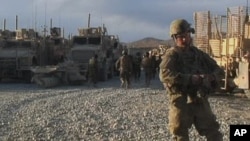The U.S.-led war effort in Afghanistan is nearing its high-water mark. With the first of America's troops slated to withdraw from Afghanistan in July, NATO is changing its strategy. Rather than trying to secure all of Afghanistan against a resurgent Taliban, the alliance is focusing its dwindling resources on a small number of population centers.
It is a calm day in Baraki Barak district, in Logar province, eastern Afghanistan. Military Police from the U.S. Army's 10th Mountain Division patrol the district center alongside Afghan police.
The local residents are receptive, even friendly. Some men just want to chat. Others volunteer to join a new neighborhood watch.
It is just another day in one of the communities enjoying a sustained NATO and Afghan government presence.
But just a few kilometers away, the roads are nearly impassable due to improvised explosive devices. Taliban snipers stalk NATO troops.
Ten years into the Afghanistan war, the U.S.-led alliance has reached its maximum size of around 150,000 troops. American forces are scheduled to begin a slow withdrawal starting in July.
Realizing it cannot patrol and develop all of Afghanistan, NATO has identified some 80 of Afghanistan's roughly 400 districts as key terrain districts. These will receive a growing proportion of troops, construction projects and other assistance.
Baraki Barak, with about 80,000 people, is the only one of seven districts in Logar province to receive the key designation. Baraki Barak boasts a large bazaar, plus several important roads. Residents have strong ties to Kabul.
"It's sort of a happening place, for lack of a better term, said Captain Paul Rothlisberger of the U.S. 10th Mountain Division
Since moving into Baraki Barak in 2009, NATO has completed a large number of reconstruction projects, including this orchard.
In addition, U.S. State Department officials have helped to set up a new district government.
The flip side of the key-terrain-district strategy is that the remaining districts receive less attention. These include some strategic border districts that have become Taliban strongholds.
U.S. Army officers admit the strategy is not perfect. But they say it is the best way to apply dwindling resources and buy time for the Afghan government, or GIROA, and the Afghan National Security Forces.
"Our priority is to focus where the population centers are because our primary task here is to secure the populace. So, our idea is if we can provide security to the populace, they will buy into GIROA and the Afghan National Security Forces and once we have that accomplished in the heavily-populated areas, we can move out into the less populated areas," said Captain Rothlisberger.
With NATO troop levels scheduled to steadily decline starting this summer, time is running out for this strategy to work.










